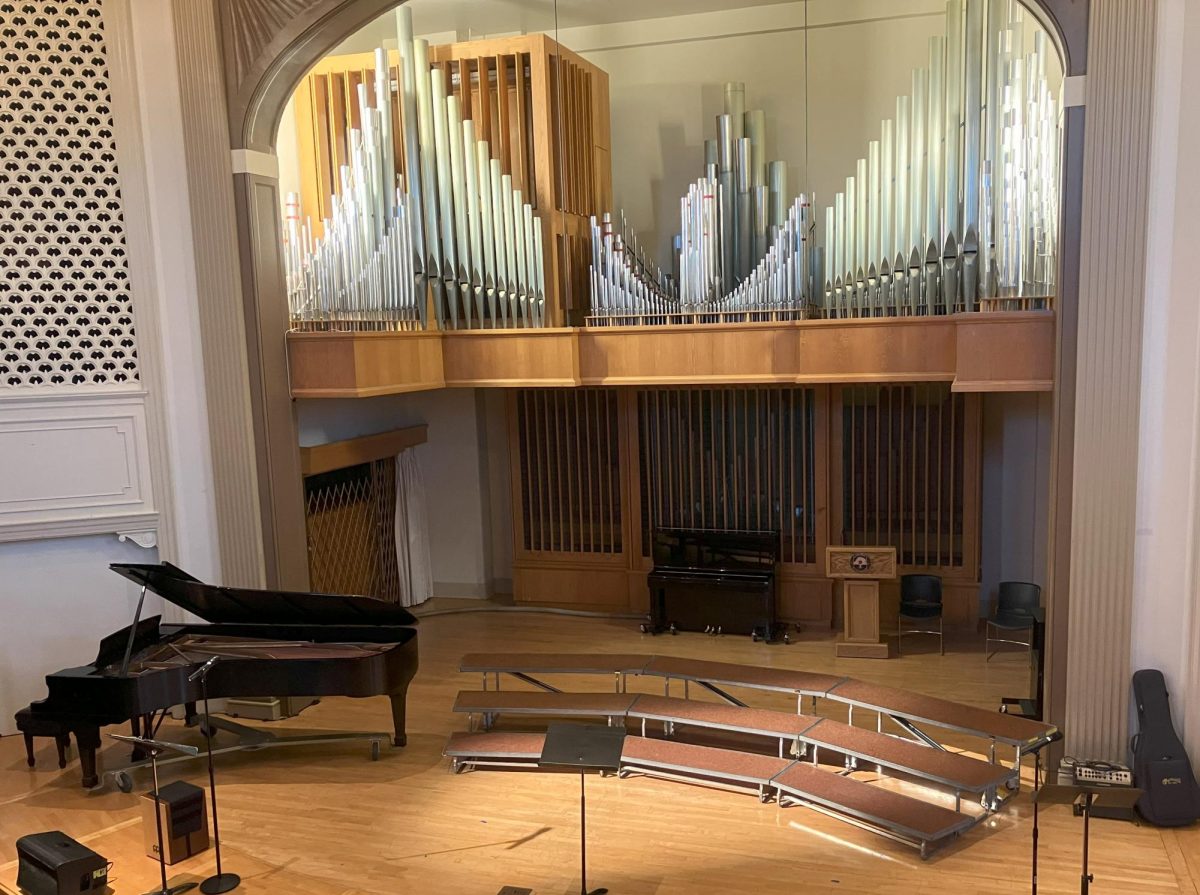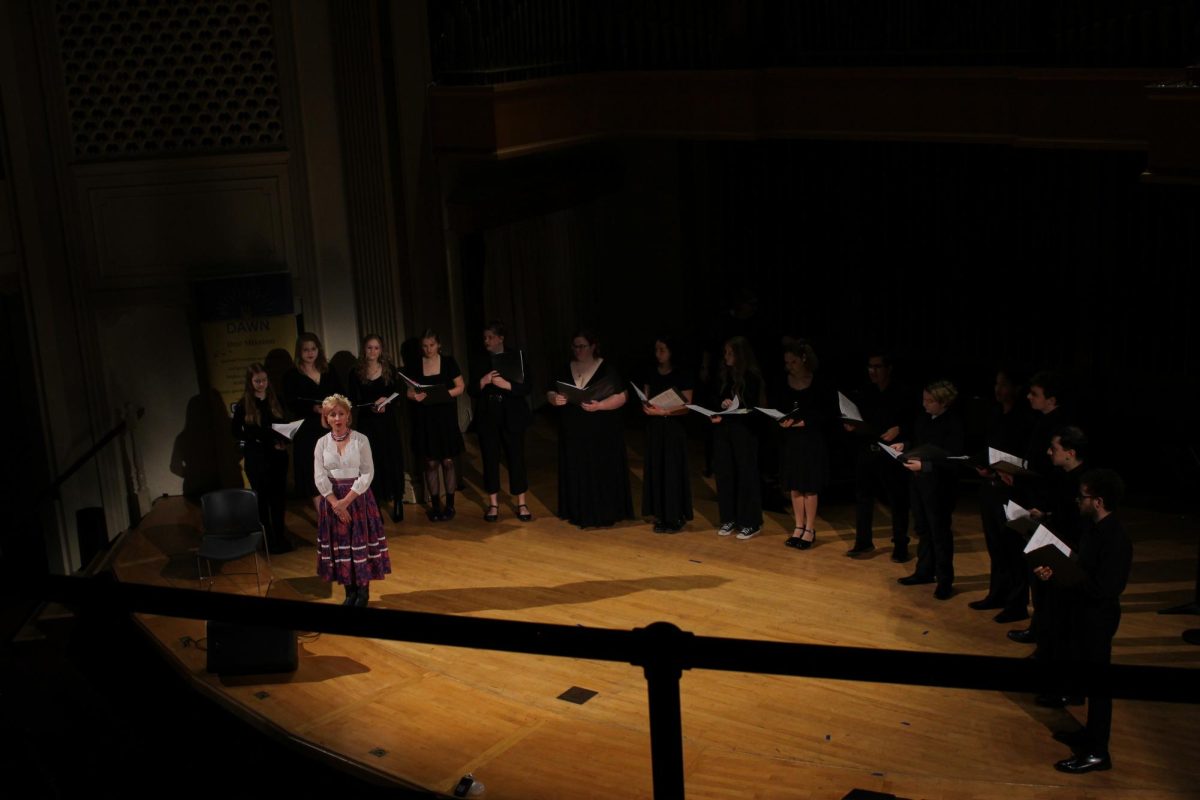Lizzie Martinez
Senior reporter
The facts may be disheartening: a fourfold increase in weather-related disasters in the last 30 years, more than 1,000 tornadoes in 2004 and global temperature increases of five degrees. But, the future is full of hope, according to former Oregon Secretary of State Bill Bradbury.
Bradbury spoke to a group of 70 in Ice Auditorium on April 8. He presented a slideshow on environmental stewardship and the state of climate change in the world with a special focus on Oregon.
“I think it’s a challenge to deal with climate change, but it is also an opportunity,” Bradbury said.
He spent the remaining half-hour discussing ways for everyone, from nations to corporations to college students, to help reverse the damage.
“College and high school students are some of the most powerful people because when they get together, they can have an incredible effect because it’s thoughtful, young people saying, ‘Hey, this is the world we have to live in,’” Bradbury said.
The most important message Bradbury delivered was that climate change is real, and it is affecting everyone right now.
“I try to bring climate change to life, but also to make it clear that it’s not just in the Arctic—it’s here,” he said. “We’d be a lot better off if we deal with it than not.”
Bradbury serves on Oregon’s Global Warming Commission, and he is now conducting outreach to Oregonians on climate change in their own backyard. His presentation includes data on the Columbia River Basin, Rogue Valley and the plights of the salmon and the Oregon bark beetle.
For junior Leah Julius, climate change hits close to home—her family’s home, that is, in the Puget Sound near Seattle.
“We live on the edge of a cliff, and every year we can see the cliff coming closer to our house,” Julius said. “It’s really scary.”
This erosion was one of the subjects Bradbury raised during his presentation. Rising wave patterns are increasing erosion in many coastal areas.
“What global warming means is that 100-year floods are more likely to occur every few years instead of every 100 years,” Bradbury said. “That’s what climate change means: It’s drier, and its wetter.”
In the last 30 years, floods, tornadoes, droughts, blizzards, hurricanes and fires have run rampant. In 2006, there were nearly 400 such disasters in the United States alone.
These weather changes, especially the rising global temperatures, have had a negative impact on countless species, Bradbury said.
For example, the Oregon bark beetles are now surviving the warmer winters, resulting in extensive tree loses in Oregon forests.
Even these effects in Oregon can still seem far away for Linfield students. Junior Joy Nelson attended the presentation to learn more about climate change. Even though she said it’s not directly affecting her life, she is still trying to reduce her footprint on the world.
“I do everything I can,” Nelson said. “I don’t own a car; I recycle; I compost and turn down the heat.”
Junior Duncan Reid, president of Greenfield, organized this event after he heard Bradbury speak at McMinnville Cooperative Ministries on Feb. 24.
“I wanted to bring a focus to the issue of climate change,” Reid said. “The presentation is similar to ‘An Inconvenient Truth,’ but it has a focus on Oregon that brings it home.”
Fliers were distributed with information on how students can alleviate climate change; an e-mail list was available to receive advanced tips on reducing carbon footprints. Students were exhorted to be politically active in changing their local and state governments’ priorities.
Despite all the facts and suggestions, Bradbury wanted the attendees to take away one message
especially: “The science community has come to a consensus: Climate change is real. We are seeing the effects all over the world. And it is something we need to deal with.”
The presentation ended with an invitation for students to sign up to be a “Climate Cooler.”







Kathleen Blair • Apr 14, 2009 at 10:46 am
Bradbury puts on a great presentation and he’s right.
Unfortunately green-washing is endemic, particularly locally, by groups who give lots of lip service to wanting to do something about global warming, while remaining content to be hypocritical green-washing fronts for the realtors and developers. No one who let’s their abject terror at these circumstances should allow themselves the luxury of turtling and green-washing just to make themselves feel better. They also shouldn’t let their lack of character and leadership prompt them to name call other people, who have degrees in climate science, as “kooks” and “intellectually spurious” who are willing to take real actions that will reveal the green-washers for what they really are.
The United Nations is now calling global warming “catastrophic climate readjustment” and is predicting water shortages to accompany the climate problems which translate directly into the same problems locally here in Mac.
Climate change isn’t just about carbon, it’s also about deviant albedo rates caused by too many acres of rooftop and asphalt, *plus* the loss of soil mass which acts as a carbon sink. you can’t sequester carbon without soil mass.
The first step to Cooling the Climate is to *stop* all new construction on previously un-built on ground, unless and until:
1. the *entirety* of the existing built environment is thouroughly retrofitted with every available technology that will create a 0-carbon, 0-heat, and 0-net water building.
2. all parking lots are converted to grass-parking lots
3. mass transit and a commuter train from Portland down through Mac and to the Coast is accomplished and up and running.
Then and only then can we begin to look at new construction, but even then, for every new piece of the built environment, an equal amount of existing built environment must be taken down and converted to carbon sequestering crop-land.
This is the only moral, ethical and sane solution. Anyone who says it isn’t, is just bitching about their *speculative* profit margins being impinged upon.